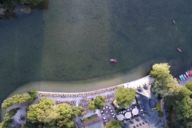
Munich is big. Munich is alive. And Munich is green. Parks, gardens and the Isar River offer the perfect balance to city bustle, sightseeing and shopping. The city can look back on a long tradition of historical gardens. The park of Schloss Nymphenburg (palace) was established already in the 17th century and the Englischer Garten (park) in the 18th century. Today the locals and their guests can enjoy their time out in public parks extending over roughly 5,680 acres.
You can feel like a princess or a prince while strolling through the park of Nymphenburg Palace. Small splendid buildings such as the Amalienburg, Badenburg or Pagodenburg are waiting to be discovered in the gardens of the 18th century. Basins, fountains, lakes and ponds, bridges, small saletta, cabinet and ornamental gardens are ideal for sparking the imagination of walkers. You want another baroque garden? Schleissheim's Palace Park with its historic canals, fountains and boskets takes visitors back in time to the courtly past.
The English Garden with its four square kilometres of green space is said to be even larger than Central Park in New York. In any case, it offers enough space for sports and relaxation. Quietly and idyllically, the northern part invites those seeking relaxation to relax on the spacious meadows. The true connoisseurs stretch their hammock between two trees and let legs and soul dangle. In the southern part of the city there is a lively atmosphere, for example at the Eisbach, where the river surfers ride on a standing wave, at the meadow below the Monopteros, where slackliners, ice cream vendors and bongo players romp about or in the beer garden at the Chinese Tower, where you can enjoy a snack, beer and limo.
Right next to the Residenz, the city palace of the Wittelsbach family, the Hofgarten invites you to let the sun shine on your nose. The crunching of the pebbles on the paths, the soft clack of boules and the tango sounds, to which couples dance in the Hofgarten Pavilion, also contribute to the carefree atmosphere. There is no better place to relax in the city centre than in this courtly Renaissance garden.
The renowned historic botanical garden with its 14,000 plant species is located to the north of Nymphenburg Palace Park. Especially in winter the greenhouses with tropical temperatures, exotic plants and tropical butterflies let you forget rain, cold and slush.
Nearby, the Hirschgarten with real deer, water playgrounds and Munich's largest beer garden invites you to linger. The Hirschgarten can look back on a long history: In the summer of 1780, Elector Karl Theodor had a fenced-off “zoo“ built on the grounds and occupied by over a hundred fallow deer and noble deer. Only a few years later it was made accessible to the public. There was also a predecessor of today's inn and beer garden “Royal Deer Garden“, the hunter's lodge. The Magdalenenfest, which takes place annually at the end of July in the Hirschgarten, is a real insider's tip among the Munich folk festivals.
In the summer of 1780, Elector Karl Theodor had a fenced-off “zoo“ built on the grounds and occupied by over a hundred fallow deer and noble deer.
Cycling, tobogganing, skateboarding – the Olympic backdrop of 1972 with its impressive tent roof structures is particularly inspiring for recreational athletes. It is a special experience for competitive athletes to compete in the Olympic stadiums. Fireworks, concerts, open-air cinema and the well-established Tollwood Culture Festival attract even more than forty years after the Summer Olympics, even the less sports-loving crowds of visitors to the Olympic Park in the northwest of the city.
The Munich-based company owes its Westpark to the 1983 International Garden Exhibition IGA. Rose and farmer's garden, Greek garden and the Asian ensemble with the Nepal Pagoda and the Thai Sala are reminiscent of its origins: at the first warm temperatures, large families from a wide variety of countries gather around the barbecue sites. The film nights “Kino, Mond und Sterne“ in the amphitheatre of the park belong to the Munich summer like the sleigh ride on one of the hills in winter.
Coming from the mountains, the Isar flows through the whole city from Hinterbrühl in the south to Unterföhring in the north. Spacious gravel banks, meadows and wooded uplands accompany the river, which, thanks to the renaturation completed in 2011, is once again seeking its own bed. Birds nest on the islands and a beaver pair is also at home not far from the Deutsches Museum. Already on sunny January days you can see sun worshippers on the gravel banks.
The Petuelpark in Munich is located directly above the Mittlerer Ring, between Schwabing-West and Milbertshofen. The park above the tunnel was opened in 2004 and now serves as a recreational area for the surrounding residents. On the 900-meter-long and 60-meter-wide terrain, water games, playgrounds and many art objects provide variety. The centrally located white cube by architect Uwe Kiessler houses exhibition areas and a café.
Riemer Park with its lake was created in 2005 as an artificial landscape within the framework of the Federal Horticultural Show (BUGA) in the immediate vicinity of the exhibition grounds. It is characterized by long, linear axes and strict geometric surfaces. A special attraction in Riemer Park is the large swimming lake with its varied shores and two 20-metre-high toboggan hills. There is a large playground for children of all ages, an all-terrain playground, a skate park and two beach volleyball courts.